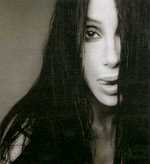 During my nightshift last week I relistened to the song “Dream Baby” (written by Sonny Bono) as I was going backwards through Cher’s catalog one night. This is Cher’s official second recording after “Ringo, I Love You” (written by Phil Spector, Paul Case, Vini Poncia and Peter Andreoli), this one initially released as Cherilyn before appearing on Cher’s first solo album, All I Really Want to Do. Both singles were released in 1964.
During my nightshift last week I relistened to the song “Dream Baby” (written by Sonny Bono) as I was going backwards through Cher’s catalog one night. This is Cher’s official second recording after “Ringo, I Love You” (written by Phil Spector, Paul Case, Vini Poncia and Peter Andreoli), this one initially released as Cherilyn before appearing on Cher’s first solo album, All I Really Want to Do. Both singles were released in 1964.
Spectorphilia aside, this is clearly a better song.
But I could hear what sounded like Wall-of-Sound production on the track and remembered reading how Sonny’s early records with Cher relied on the production formulas he learned while working for Phil Spector. So I went to speak to Cher scholar Robrt Pela to ask him exactly what was going on here. We had been talking about something else…and so I said,
“Unrelated, I was just going to email you. What are the vocal tricks that are used on Cher’s voice in Dream Baby? Is it just wall of sound? Cher sang the part over and over and they layered it? Or she just sang it once and they layered it? What’s happening there? I just want to make the case that studio/technology manipulations were being used on Cher’s voice from day one so calm down about autotune, grumpy people.”
I had an agenda see? And this is the awesomeness I got in return:
“I love that you’re making this point about Cher!
‘Dream Baby’ uses a wall-of-sound trick called ‘double tracking;’ The same vocal is used twice, on separate tracks, to make it sound ‘doubled..’
It’s a studio trick used a lot by the Bahler brothers, especially when they were recording backgrounds for Partridge Family records; they would double or triple track their backgrounds because they were approximating a sound made by five or six singers (David Cassidy plus the other five members of the PF).
The best way to tell the difference between double-tracking and the kind of close harmony that produces a similar effect (which you mentioned in your question about ‘Dream Baby’) is to listen to the vocals in a headset; you can tell if a singer is ‘following’ herself by recording a second vocal that mimics the first by whether there are different vocal inflections or she’s singing in a different key (usually a half-step down from the original).
Stan Ross does a fun wall-of-sound trick at the top of ‘Dream Baby’ where he ‘wah-wahs’ Cher’s vocal by moving it quickly back and forth between the left and right channels. Why he doesn’t do this again in this song is beyond me, but it’s a keen kickoff to this record.
It’s interesting to listen to the four primary versions of this song: the original mono mix; the original stereo mix; the 1999 remaster and the later 2005 remaster. I like the original stereo version best.”
Watch Cher lip synch the song on Shivaree badly in 1965.
Unrelated: Tom Bahler talks about how he wrote “Living in House Divided” for Cher.


Leave a Reply